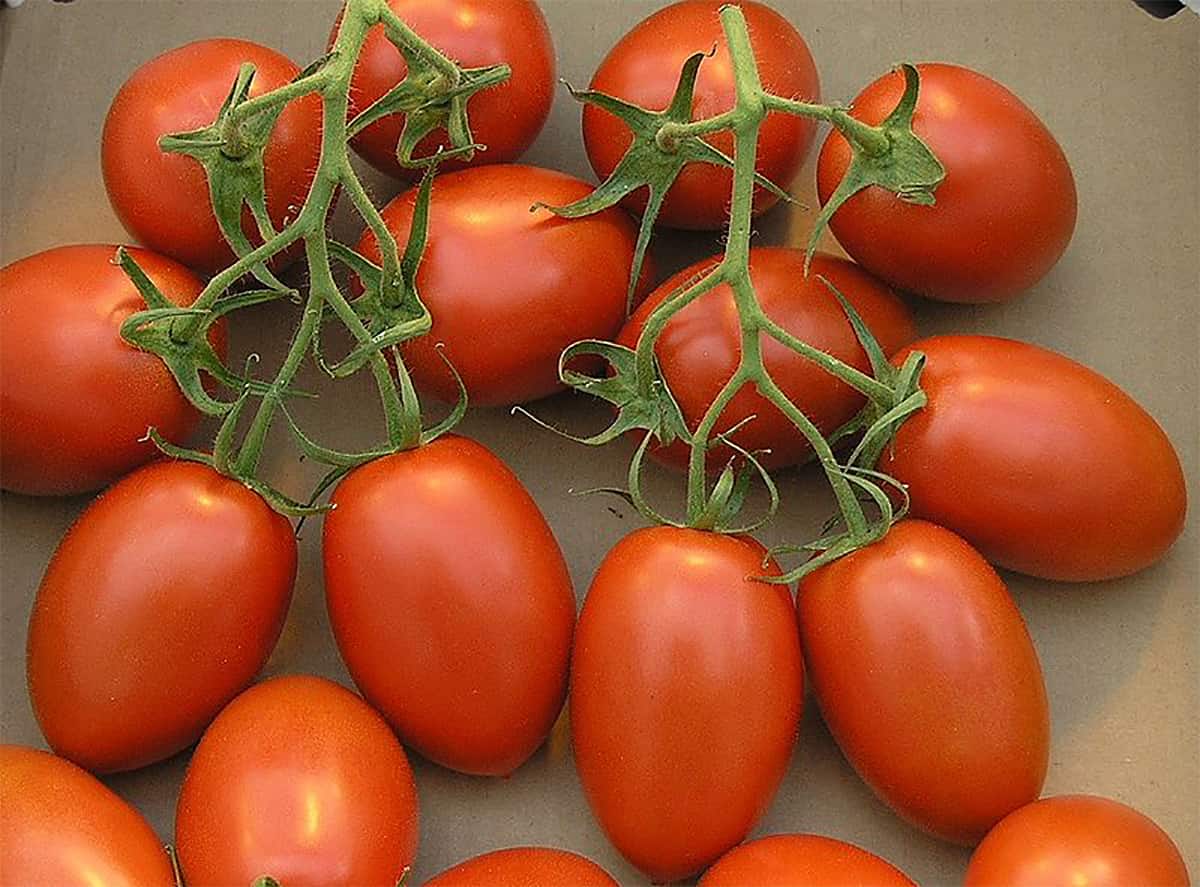If you’re passionate about tomatoes—whether you’re a home cook, food blogger, or professional chef—understanding the differences between Roma tomatoes Vs plum tomatoes can enhance your cooking and nutritional choices. These two types of tomatoes are often used interchangeably, but they differ significantly in taste, texture, culinary uses, and health benefits.
In this guide, you’ll discover everything from their origin stories to expert-backed health benefits. We’ll explore the differences in depth to help you make informed choices.
What Are Roma Tomatoes?

Ripe Roma tomatoes with firm flesh and minimal seeds—ideal for sauces and canning. Credit: wikipedia
Characteristics
Roma tomatoes are oval-shaped, medium-sized tomatoes with a meaty texture and few seeds. Also known as Italian plum tomatoes, they are firm and have a lower water content compared to other varieties. Their dense flesh makes them ideal for sauces, soups, and canning.
In terms of size and appearance, Roma tomatoes usually range from 2 to 3 inches in length and are bright red with smooth skin. Their mildly sweet, slightly tangy flavor profile is ideal for dishes that require a concentrated tomato essence without excessive juice.
Origin and History
Despite their name, Roma tomatoes didn’t originate in Rome. In fact, they originated in Mexico and were first developed in the 1950s through agricultural breeding programs in the United States. Their popularity grew due to their resilience in cooking and suitability for preserving.
Culinary Uses
Roma tomatoes are prized for their versatility in the kitchen. Their low moisture content and rich flavor make them excellent for:
- Marinara and pasta sauces
- Tomato paste
- Salsas and chutneys
- Roasting or grilling
- They’re also great in salads when you want extra texture
Their firm flesh also holds up well during cooking, making them ideal for slow-cooked meals.
What Are Plum Tomatoes?

plum tomatoes maturing on the vine—perfect for garden-fresh sauces and salads, Credit to: a-z-animals.com
Characteristics
Plum tomatoes, like Roma, have an elongated shape but are often slightly larger. They have thick flesh, minimal seeds, and a robust, slightly sweet flavor. Plum tomatoes are sometimes referred to as paste tomatoes because they are often used to make tomato paste and canned products.
Their bright red color and balanced acidity make them a favorite among both chefs and home cooks.
Origin and History
Plum tomatoes are believed to have originated in South America, particularly Peru and Ecuador. They made their way to Europe in the 16th century, brought back by Spanish explorers. Originally used as ornamental plants, plum tomatoes later found their way into Mediterranean cuisine, especially in Italian dishes.
Today, they are cultivated worldwide, with Italy, Mexico, and the U.S. being major producers.
Culinary Uses
Due to their rich and slightly sweet flavor, plum tomatoes are commonly used in a variety of dishes:
- Tomato sauces and pastes
- Pizza toppings
- Bruschetta and crostini
- Grilled or roasted dishes
- Fresh salads
Their thick skin and flesh helps them maintain their shape during cooking, and their balanced sweetness enhances various recipes.
Roma vs Plum Tomatoes: Comparison at a Glance
| Feature | Roma Tomatoes | Plum Tomatoes |
|---|---|---|
| Shape | Oval, slightly smaller | Oval, slightly larger |
| Texture | Dense, meaty, low water | Thick flesh, juicy but firm |
| Flavor | Mildly sweet and tangy | Sweeter with a hint of acidity |
| Culinary Use | Sauces, pastes, canning, soups | Sauces, roasting, fresh dishes |
| Seed Count | Low | Low |
| Water Content | Lower | Slightly higher |
| Origin | Mexico | Peru/Ecuador |
Comparing the Flavor Profiles
Roma Tomatoes
Roma tomatoes have a concentrated flavor that leans toward tangy but not overly acidic. This makes them ideal for slow-simmered sauces where a bold tomato taste is essential. Their subtle sweetness also complements herbs like basil and oregano beautifully.
Plum Tomatoes
Plum tomatoes are slightly sweeter and more aromatic, making them perfect for fresh preparations and recipes that highlight the natural tomato flavor. Their juicy interior and rich texture make them ideal for tomato juice, salad, or tomato-based drinks.
As someone who cooks with tomatoes almost daily, I’ve noticed that plum tomatoes give my bruschetta a richer mouthfeel, while Roma tomatoes are my go-to for any tomato-based stew.
Size and Appearance
Roma tomatoes typically range from 2 to 3 inches in length and are slimmer with a smoother surface. Their consistent size and firmness make them ideal for uniform slicing and dicing.
In contrast, plum tomatoes are usually larger, ranging from 2.5 to 4 inches, and may have a more pronounced point at the bottom. Their vibrant red color often stands out more due to higher lycopene content.
Beyond their physical differences, Roma and plum tomatoes also vary slightly in nutritional value.
Nutritional Comparison: Roma Tomatoes vs Plum Tomatoes
Both Roma and plum tomatoes are low in calories, rich in antioxidants, and offer valuable vitamins and minerals—but they do have subtle differences in nutritional composition.
| Nutrient (per 100g) | Roma Tomatoes | Plum Tomatoes |
|---|---|---|
| Calories | ~18 kcal | ~20 kcal |
| Carbohydrates | ~3.9 g | ~4.2 g |
| Fiber | ~1.0 g | ~1.2 g |
| Protein | ~0.9 g | ~1.0 g |
| Vitamin A | ~833 IU (17% DV) | ~1025 IU (21% DV) |
| Vitamin C | ~23 mg (25% DV) | ~27 mg (30% DV) |
| Lycopene (antioxidant) | ~2573 µg | ~3041 µg |
Sources:
If you’re interested in how other popular foods stack up nutritionally, check out our in-depth comparison of House Salad vs Caesar Salad: Which One Is Healthier and Better for You.
Health Benefits of Roma vs Plum Tomatoes
Both Roma and plum tomatoes are nutrient-dense, offering numerous health benefits:
Roma Tomatoes
- Rich in Vitamin A: Supports vision and immune function.
- High in Lycopene: An antioxidant linked to reduced cancer risk (breast and prostate) and cardiovascular health.
- Good Source of Fiber: Supports digestion and helps with weight management.
- Low in Calories: They are ideal for calorie-conscious diets.
According to the eatthismuch, Roma tomatoes provide about 18 calories, 1 gram of protein, and 1 grams of fiber per 100 grams. (Source)
Plum Tomatoes
- High in Vitamin C: Strengthens the immune system and aids in collagen production.
- Contains Vitamin K: Important for bone health and blood clotting.
- Rich in Antioxidants: Helps fight inflammation and oxidative stress.
The NIH highlights the importance of lycopene and vitamin C in reducing chronic disease risk. (NIH Source)
Expert Insight
“Tomatoes are a significant source of dietary antioxidants. Lycopene, in particular, may help lower inflammation and reduce the risk of heart disease,” says Dr. Edward Giovannucci, professor of nutrition at Harvard T.H. Chan School of Public Health. (Source).
FAQs: Roma vs Plum Tomatoes
1. Are Roma tomatoes the same as plum tomatoes?
Roma tomatoes are a type of plum tomato, but not all plum tomatoes are Romas. They differ in size, flavor, and specific culinary applications.
2. Which tomato is better for sauces?
Roma tomatoes are often preferred due to their low moisture and dense flesh, which creates a richer sauce.
3. Can I substitute plum for Roma tomatoes?
Yes, they are interchangeable in most recipes, especially in cooked dishes.
4. Which tomato is healthier?
Both are highly nutritious, though Roma tomatoes may have slightly more vitamin A, while plum tomatoes often offer more vitamin K.
5. Are they good for weight loss?
Absolutely! Both types are low in calories and high in fiber, making them excellent for weight management.
Final Thoughts
Whether you choose Roma or plum tomatoes, both offer outstanding flavor and nutritional benefits. For a thick, rich sauce, Roma tomatoes are the ideal choice. On the other hand, if you’re looking for a sweeter, juicier tomato for fresh dishes, plum tomatoes are the better pick.
👉 Try both in your cooking and find out which one you prefer best. Save this guide for future reference, and share it with others who enjoy cooking with fresh ingredients!

